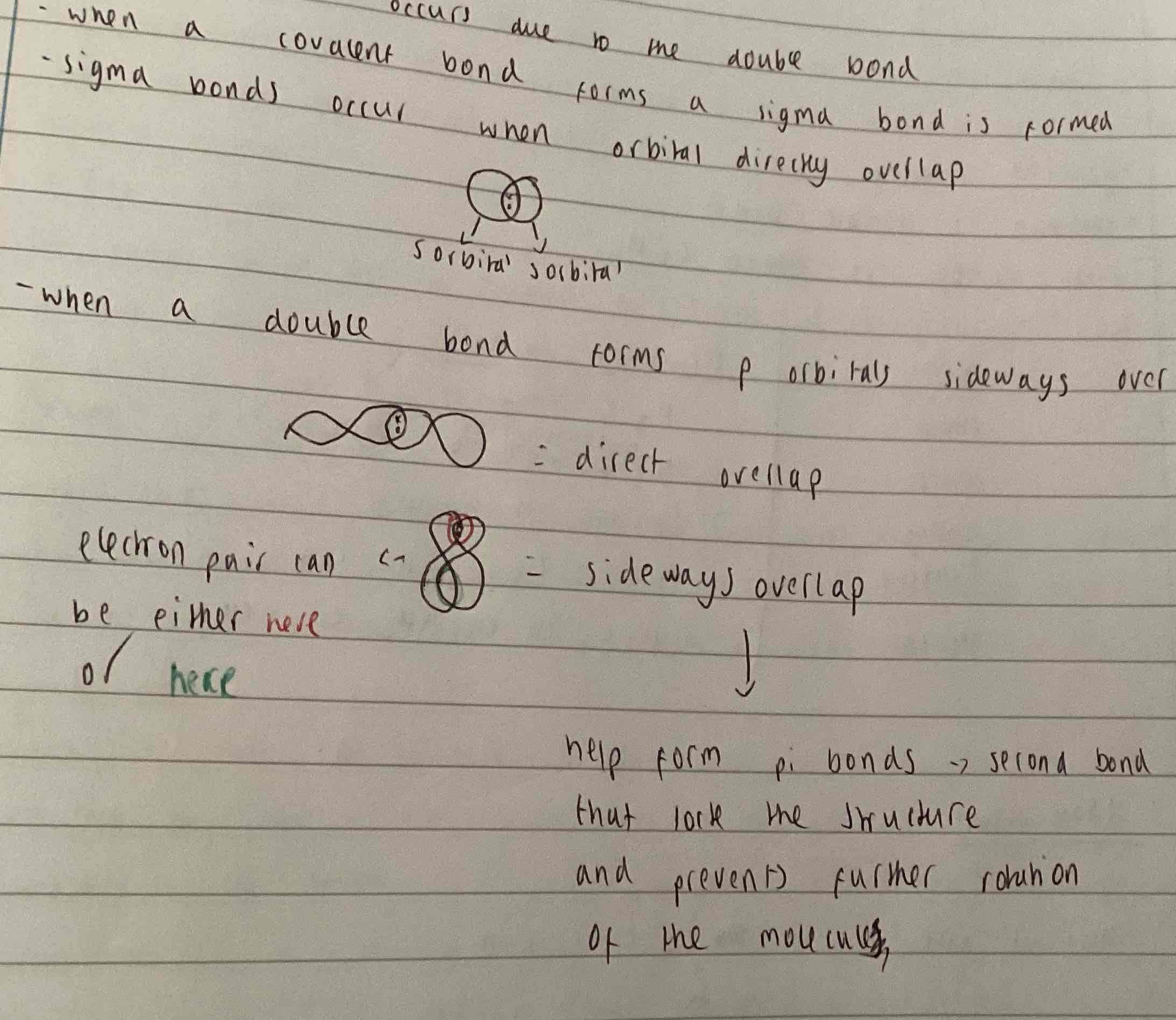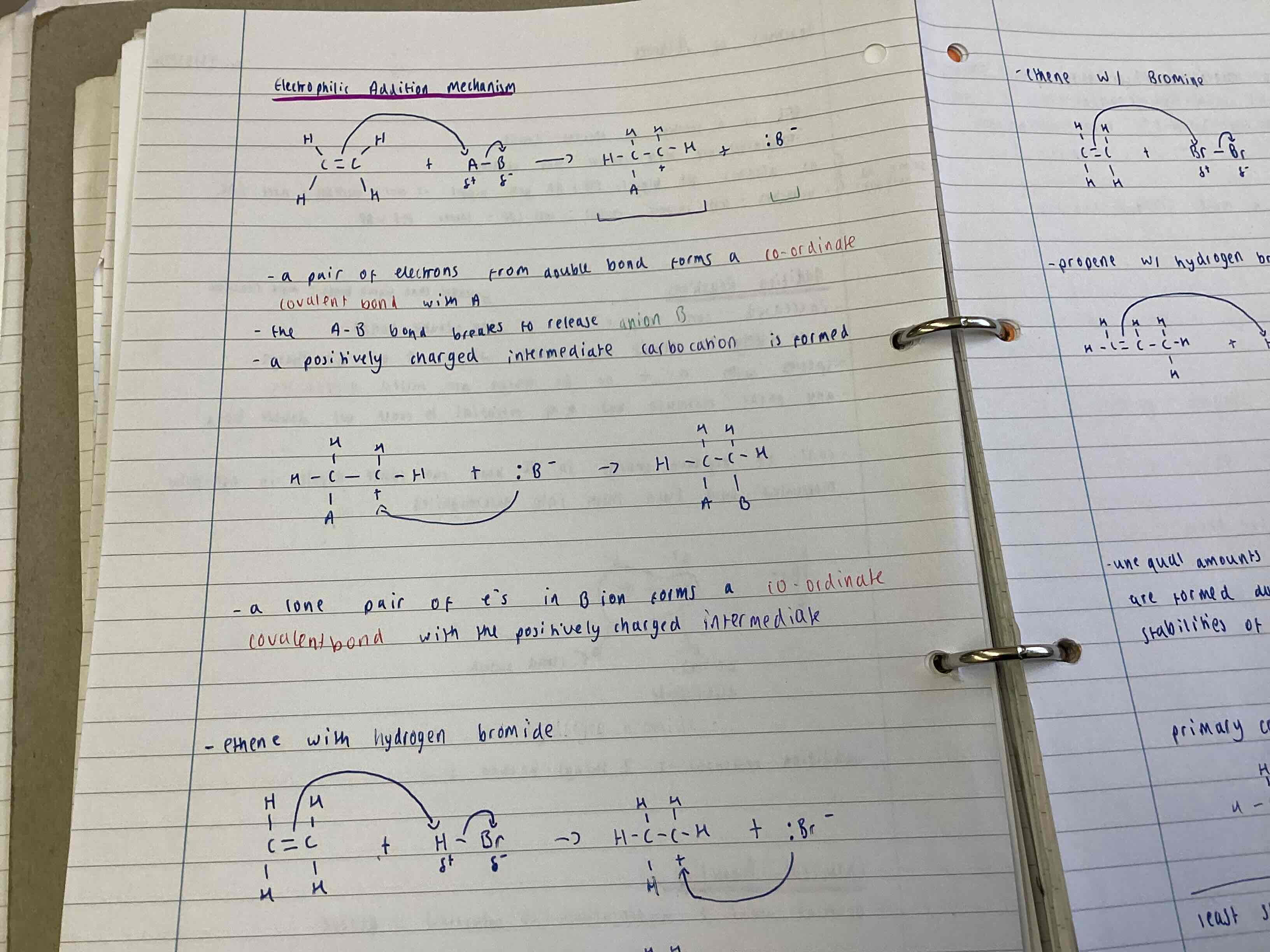Alkenes
1/39
There's no tags or description
Looks like no tags are added yet.
Name | Mastery | Learn | Test | Matching | Spaced |
|---|
No study sessions yet.
40 Terms
General formula
CnH2n
What bonds do alkenes contain
Double bonds
Are alkenes saturated or unsaturated
Unsaturated
First member of alkenes
Ethane C2H4
Structural formula of Ethel
H2C=CH2
Structural formular of propone
H2C=CH2CH3
Structural formula of butane
H2C=CHCH2CH2CH3
Why does E/Z isomerism occur
Due to the restricted rotation around the double bond
What happens when orbitals directly overlap
Sigma bonds are formed
When else are sigma bonds formed
When covalent bonds are formed
How do p orbitals overlap when a double bond forms
Sideways

What does the sideways overlap of p orbitals form
Helps form pi bonds
Pi bonds
Second bond of the double bond that locks the structure and prevents further rotation of the molecule
Single covalent bond=
Sigma bond, direct overlap
Double covalent bond=
Pi bond, sideways overlap
What kind of orbitals can overlap
P orbitals only
Shape and bond angles of alkenes
Trigonal planar- 3 areas of electron bonding, 120deg. BAs
BP/MP of alkenes
Similar trends to alkanes, increases as more carbons in formula- more atoms=more LDFs, great IM force= more energy needed to separate molecules, more energy required= higher BP
What is the state of lower member s at room temp
Gases at room temp and pressure
State of cyclohexane for isomers
Liquid- greater branching= lower bp
Solubility of alkenes
Non polar so are immiscible in water( don’t mix), miscible with most organic solvents
Where is electron density found
C=C bond
What does the electron density around the C=C bond mean
Alkenes are more reactive than alkanes
Are pi or sigma bonds more reactive
Pi bonds re more reactive as they are weaker than sigma bonds
What does an increased concentration of e- in pi bonds mean
Likely to attract ny species with a plus or delta + charge
Electrophiles
Species with a + or a delta+ charge
Which molecules have potential to react with double bond
Any polar molecules
What can the concentration of negative charge in the pi bond do
Induce dipoles in no polar molecules and turn them into electrophiles
Bromine water test
Colourless= alkene, no change= alkane
Electrophilic addition mechanism
A pair of electrons from a double bond forms a coordinate covalent bond with A of C2H4+ AB, the AB bond breaks to release anion B, a positively charged intermediate carbocation is formed, a lone pair of electrons in B ion forms a coordinate covalent bond with the positively charged intermediate

What happens wen the alkenes are unsymmetrical
Unequal amounts of each product are formed due to relative stabilises of carbocation intermediates
Primary carbocation
C+ bonded to one other C
Secondary carbocation
C+ bonded to 2 other Cs
Tertiary carbocation
C+ bonded to three other Cs
What are reactions most likely to happen with
Most stable carbocation
Stability’s of carbocation
Primary= least, tertiary- most
Conditions for alkenes reacting with hydrogen
Nickel catalyst, 300-400 deg c
Conditions needed for alkenes to react with water
Steam hydrogenation
Conditions needed for alkenes reacting with chlorine or another halogen
Room temperature, halogen
Conditions for steam hydrogenation of ethane to make ethanol
React with steam at 320 deg c, phosphoric acid (H3PO4) catalyst